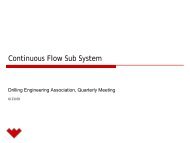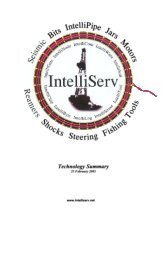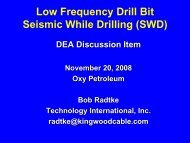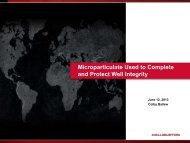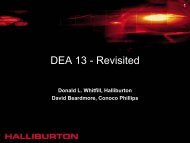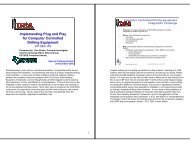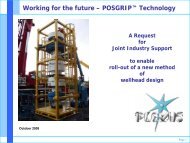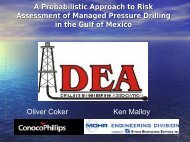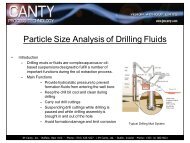Jay Turner, Halliburton Baroid - Drilling Engineering Association
Jay Turner, Halliburton Baroid - Drilling Engineering Association
Jay Turner, Halliburton Baroid - Drilling Engineering Association
- No tags were found...
You also want an ePaper? Increase the reach of your titles
YUMPU automatically turns print PDFs into web optimized ePapers that Google loves.
IntroductionPast Methods of Controlling Heat Loss from Tubing• Multiple methods have been applied:– Vacuum insulated tubing (VIT)– Non-aqueous insulating packer fluids– Aqueous insulating packer fluids• Numerous disadvantages:– VIT: cost, “hot spots”, strength, running– IPFs: density, thermal stability, environmental, etc.• Aqueous IPFs offer an attractive alternative“For External Distribution, © 2007 <strong>Halliburton</strong>. All Rights Reserved.”
IntroductionAdvantages of Aqueous IPFs• Less costly than VIT and some non-aqueous fluids• Easily placed in annuli versus running VIT• Potentially more reliable than VIT• Can be formulated solids-free versus non-aqueous fluids• Can be more environmentally friendly than non-aqueous fluids“For External Distribution, © 2007 <strong>Halliburton</strong>. All Rights Reserved.”
IntroductionChallenges with Aqueous IPFs• <strong>Engineering</strong> a fluid with low inherent thermal conductance• Developing a viscosifier package with adequate thermal stabilityover time• Breaking the industry paradigm concerning other options“For External Distribution, © 2007 <strong>Halliburton</strong>. All Rights Reserved.”
DevelopmentalObjectives“For External Distribution, © 2007 <strong>Halliburton</strong>. All Rights Reserved.”
Modes of Heat TransferConductiveConvectiveheat sourceWith bothmodes intact,heat transfersquickly throughliquidsheat sourceTo minimize the transfer of heat, we need to combat both modes• Low inherent conductivity (use low k liquids)• Gel the fluid to help prevent convective currents“For External Distribution, © 2007 <strong>Halliburton</strong>. All Rights Reserved.”
Thermal Limitations of Aqueous IPFsOperator testing of IPFs available in 2006 demonstratedthat none were thermally stable at 275ºF for over 28 days.All test samples lost most or all of their gel performance,thus much of their insulating value.Why did this happen?“For External Distribution, © 2007 <strong>Halliburton</strong>. All Rights Reserved.”
Eliminating ConvectionTraditionalPolymersSyntheticsandBiopolymersSyntheticsandBiopolymersX-linkSyntheticsX-linkSyntheticsX-link gelsInorganics200 o F 250 o F 375 o FIncreasing Temperature“For External Distribution, © 2007 <strong>Halliburton</strong>. All Rights Reserved.”
SystemPerformance“For External Distribution, © 2007 <strong>Halliburton</strong>. All Rights Reserved.”
N-SOLATE SystemsN-SOLATE 275:• Densities from 8.5 to 14.2 lb/gal• Thermally stable to 275° F• Thermally activatedN-SOLATE 400:• Densities from 8.5 to ~15.0 lb/gal• Thermally stable to 400° F• Thermally activatedN-SOLATE 600:• Densities from 8.5 to 10.5 lb/bbl• Thermally stable to 600° F• Not thermally activated“For External Distribution, © 2007 <strong>Halliburton</strong>. All Rights Reserved.”
N-SOLATE System PerformanceViscosity (cP)Viscosity (cP)30002500200015001000500030002500200015001000N-SOLATE TMThermal Setting of IPF OneBiopolymers0 5000 10000 15000 20000 25000Time (s)N-SOLATE TMThermal Setting of IPF Two400 System280°FN-SOLATE 400N-SOLATE 275IPF OneFluid 1Fluid 2275 System190°FIPF Two• Thermal activation ofN-SOLATE TM 400 andN-SOLATE TM 275systems• Gel strengths inhibitconvective currents• Gel strength and set timeare each adjustable tooptimumize properties50000 50000 100000 150000 200000 250000 300000Time (s)“For External Distribution, © 2007 <strong>Halliburton</strong>. All Rights Reserved.”
N-SOLATE System Performance2500Viscosity vs Temp (pre set)275 and 400 systemsare initially thinViscosity (cP)20001500N-SOLATE 275N-SOLATE 4001000N-SOLATE 600500020 70 120 170 220Temperature (F)600 system is easilypumpableAll systems enhibit athixotropic rheologyAll systems are tunableReadings were recorded at 6 rpm (10 s -1 )“For External Distribution, © 2007 <strong>Halliburton</strong>. All Rights Reserved.”
10000N-SOLATE 600 SystemN-SOLATE-600100 °F 200 °F 300 °F 400 °F 500 °F 600 °F3 rpm (5.0 s -1 )Viscosity (cP)1000100N-Solate-60060 rpm (102 s -1 )100 5000 10000 15000 20000 25000 30000 35000 40000 45000Time (s)N-SOLATE FluidThermal conductivity, BTU/(hft o F)Density, lb/galFann® 35 Viscometer,600 rpm6000.1669.5150 o F1606000.17710.5150 o F161- Application of “nano”-technology- Extreme thermal stability- Thixotropic fluid behavior300 rpm200 rpm100 rpm1251098412610288- 8.5 to 10.5 lb/gal tested- Geothermal well completions6 rpm3 rpm37344038- Steam injection processes“For External Distribution, © 2007 <strong>Halliburton</strong>. All Rights Reserved.”
N-SOLATE System PerformanceN-SOLATE TM 275 system at 300°FDay 1 Day 14 Day 28- Note complete gelation of system- Viscosity/insulating properties increase with temperature/time“For External Distribution, © 2007 <strong>Halliburton</strong>. All Rights Reserved.”
N-SOLATE System PerformanceN-SOLATE TM System Toxicity and Oil/grease TestingN-SOLATE TM Fluid 400 400 400 275Thermal Conductivity, BTU/(hr ft °F) 0.158 0.171 0.177 0.164Density, lb/gal 8.5 10.5 12.3 11.3Oil and Grease*, mg/L < 0.8 < 0.8 < 0.8 < 0.8GoM LC50**, ppm 143800 475000 265800 105000*EPA method 1664 (n-Hexane extractable, Gravimetric) was used in verifying the oil and grease content**96 h LC50 bioassay testing for mysid shrimpN-SOLATE TM System Compatibility• IPF compatibility was tested against predetermined contaminants:-Glycols, methanol, crude oil, control line fluids, etc.• Brine compatibility was tested as well:- CaBr2, NaBr, NaCl, Formates, etc“For External Distribution, © 2007 <strong>Halliburton</strong>. All Rights Reserved.”
RemovalStrategies“For External Distribution, © 2007 <strong>Halliburton</strong>. All Rights Reserved.”
N-SOLATE Removal Strategies• System should be removable from the wellbore during interventions, etc.• Fluids registering on-scale at 300 rpm on the Fann 35 viscometer arereadily pumpable (300 dial reading at 300 rpm ≈ 3000 cP)• N-SOLATE 275 and 400 systems are thin when placed and then willthermally activate to minimize convective currents• N-SOLATE 600 is placed “thick” but is highly shear-thinning“For External Distribution, © 2007 <strong>Halliburton</strong>. All Rights Reserved.”
N-SOLATE Removal StrategiesViscosity vs Temp (post set)10000Tunable gelationViscosity (cP)8000600040002000N-SOLATE 275N-SOLATE 400N-SOLATE 600Adequate viscosity tominimize convectionPumpable from thewellbore00 50 100 150 200 250≈ 600 psi lift pressureTemperature (F)Readings were recorded at 6 rpm (10 s -1 )“For External Distribution, © 2007 <strong>Halliburton</strong>. All Rights Reserved.”
Summary of ExperimentsPropertyEnvironmentally friendlyThermal stabilityThermal conductivities (k)Density rangeTunable rheologyContaminant compatibilityHydrate inhibitiveLow TCTCommercially available additivesCan be removed from annulusEssentially non-corrosiveDetailsPasses oil and grease; GOM toxicity90 – 600 °F or 32 – 315 °C0.177 – 0.123 BTU/hft°F8.5 ~ 15.0 lb/gal or 1.02 ~ 1.80 SGPump viscosity, gel strength, gel set timeBrines, glycols, control line fluids, pH, etc.8500 psi at 40 °F< 20°F at ambient< 38°F at 10,000 psiEasily obtainableUtilization of breaker or dilutionUnique base fluidAttainYYYYYYYYYYY“For External Distribution, © 2007 <strong>Halliburton</strong>. All Rights Reserved.”
QUESTIONS?“For External Distribution, © 2007 <strong>Halliburton</strong>. All Rights Reserved.”



